Finally, the snow show came to my doorstep. The International Snow Science Workshop has been high on my tick list for years and now as the colorful leaves of fall began blowing off the trees, I was on the road to Anchorage’s convention center on the other side of the Chugach. The road trip over Thompson Pass reminded me of how much snow surrounds our lives in Alaska. In mid-September, deep snow had returned, smothering the mountaintops and glaciers and terminating the briefest of summers in my memory.
My wife knew how excited I was about getting immersed in snow science for a week. I was lousy at science in high school and college, but figured my practical ski experience would help bridge that gap. Most of my Valdez neighbors would think that four days of lectures on snow would lull most anyone to sleep, but the ISSW abstracts contained enough familiar topics encoded in the titles to have secured my attention weeks before the workshop. Just as the winters had piled 10,000 inches of snow on my head during thirty winters in Valdez, I was about to huck a huge education gap into hundreds of white papers on the topic of snow and, as the ISSW brochure put it, the “merging of theory and practice.”
When I first saw the striking features of the Dena’ina Center on 7th Avenue, it seemed too elegant for Alaska. I swung open the massive glass doors and stepped into the illusion of an enormous ice cave. Massive overhanging levels, long stairs and escalators broke the sky above. After registering I was given a handful of tickets, bags and swag and wandered off to look at posters and booths. I was in heaven staring at aisles of posters covered with diagrams and pictures on every imaginable thing related to avalanches. Suddenly an air bag whooshed open, startling me, and I smiled.
Within a few hours I was engrossed in a discussion with a snow scientist from Europe in a small café a block from the convention center. The conference hadn’t even started and I was already in the deepest conversation about snow I’ve had in years.
Kudos to the volunteers, especially the Friends of the Chugach Avalanche Center, who seemed to be everywhere guiding conferees. I think all Alaskans who attended the sessions were humbled by the presence of so many visitors and technical presentations.
I attended every session and followed each speakers paper while scrolling through the PDF version on my laptop. Some papers were quite technical but still fascinating.
Early on, attendees oohed and were awed by a presentation on surface hoar created in a lab. You could feel the energy in the room as we watched a video of hoar frost developing in 3D. This was the type of gap I was hoping to bridge in my understanding of surface hoar. More information on this topic can be found in a paper titled “Analysis of Surface Hoar Growth under Simulated Meteorological Conditions” by Brad Stanton (MSU). Hopefully they will make the video available soon. The abstracts for all the papers presented can be found on the ISSW website.
Another fascinating paper was presented on “Cooling and Avalanches” (Goddard-CAC). After the presentation, I could not help but think there may be a need for a one-hour rule (such as the common 24-hour Rule) on cold, clear, windless nights during periods of snow stability. The paper suggested that temperatures drop fastest just after sunset and, further, showed that a temperature gradient rapidly moving either up or down has destabilizing consequences on hidden weak layers in the snowpack. The problem is that backcountry users typically assume stability increases as conditions cool. Thus, “cool down avalanches” are something we need to be more aware of in Alaska, particularly in the Chugach where heavy snow is often a major precursor to this phenomenon. In the conclusions of the paper, the author states, “In every case, experienced locals were surprised by the events [cool-down avalanches].” This got my attention and so another gap was narrowed, pointing me towards more conservative travel on amazing moonlight ski excursions.
By the third day I obviously needed a note pad (words alone weren’t sufficient within this international group) to share my thoughts as we bumped along on the Alaska Railroad during the field day. We trudged up to Moose Pass and back, hammered by gale force winds against a backdrop of flood warnings while we viewed avalanche chutes filled with green grass and thundering waterfalls.
Eventually I was scribbling down my own methods for route finding for my fellow travelers. I doubt that I broke the language barrier, but we all had fun with my yellowing paper on “Variability On The Up Axis-Y?” (Kinney).
In another session, we were introduced to Michael Peterson, a top-level video game programmer living in Hawaii who has little interest in snow or skiing as far as I could tell. He had been asked to help develop a program showing avalanching scenarios on existing digital terrain models that would allow a better understanding of flow. He nailed it. His video creation was by far the best model of a flowing avalanche that I have seen. His work is contained in a paper titled “Modeling and Visualizing Avalanche Flow Using Genetic Algorithms and OpenGl”(Delparte).
An excellent presentation was given on air bag systems (ABS) survival rates titled “On the Effectiveness of Avalanche Balloon Packs” (Haegeli). While it doesn’t take a rocket scientist to know our survival chances increase by staying on top of an avalanche and data provides ample evidence in support of wearing an ABS, I still see a few deficiencies in pack design that concern me.
There is much to be optimistic about the skiability of ABS, but the capacity of the packs for backcountry skiing leaves room for improvement. When you increase size and weight of a ski pack it must also be able to hold firmly to the back of an aggressive skier in complicated terrain. The largest pack I saw would still require me, at times, to carry gear on the outside of the pack, thus interfering with ballooning in case of an emergency. There is also the issue of carrying skis while climbing steep slopes and how that would interfere with the balloons.
Nonetheless, for most backcountry skiers the ABS should be seriously considered as the next major gear purchase. For side-country shots or heli-skiing, where carrying heavy loads is not an issue, there is a good selection already available.
Another development is a remote trigger that allows a skier to activate their partner’s ABS in case he/she are unable to react quickly enough. It’s the ultimate “I’ve got your back” tool.
At the final banquet, baked Alaska red salmon lightly sauced with speckled butter was served to the largest single gathering of avalanche minds in the world. Bill Glude presented Jill Fredston an Honorary Membership Award from the American Avalanche Association for her dedication as a scientist and as a mentor to many Alaskans, including myself. At the end of the event, Native Alaskans clad in seal skins and leather coverings, waved wild bird feathers, pounding out chants and dances choreographed hundreds of years ago.
Next year, ISSW is being held in Grenoble, France. We saw a stunning trailer that had me wishing to go…and maybe I will. But for now, it’s time to return to the central Chugach and immerse myself in another season of practicing what I learned.
© 2012

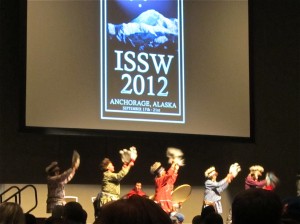
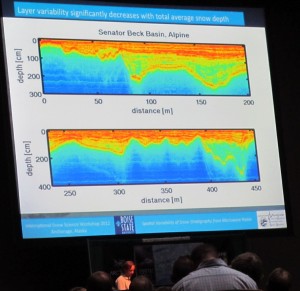
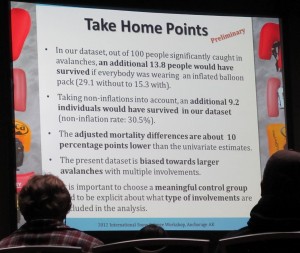
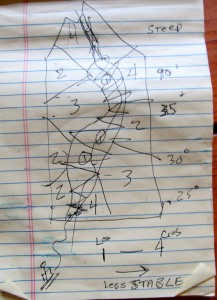
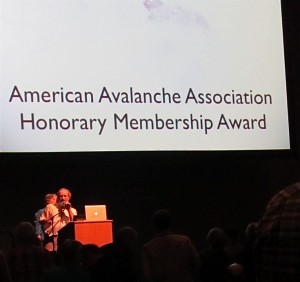
1 comment
The paper I mention above about Cooling and Avalanches is highlighted in this month’s Feb 2013 Avalanche Review.